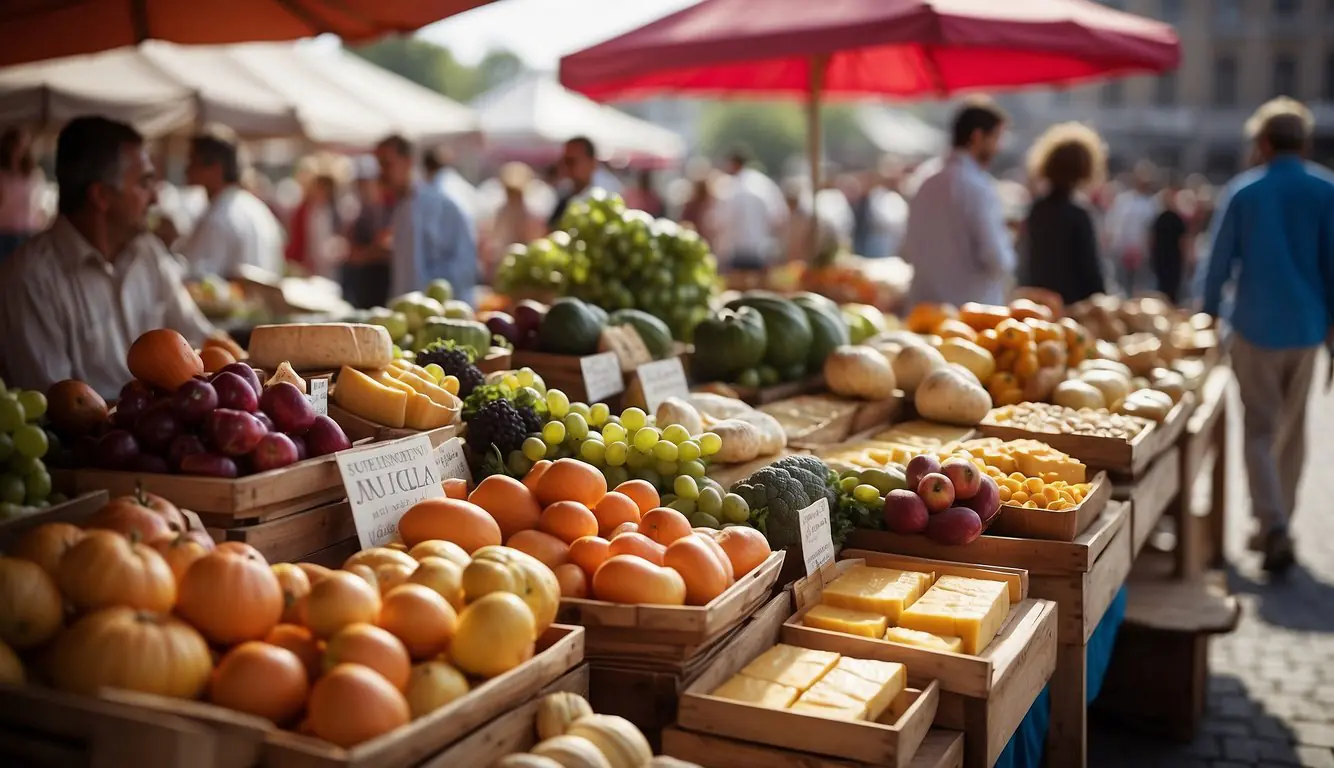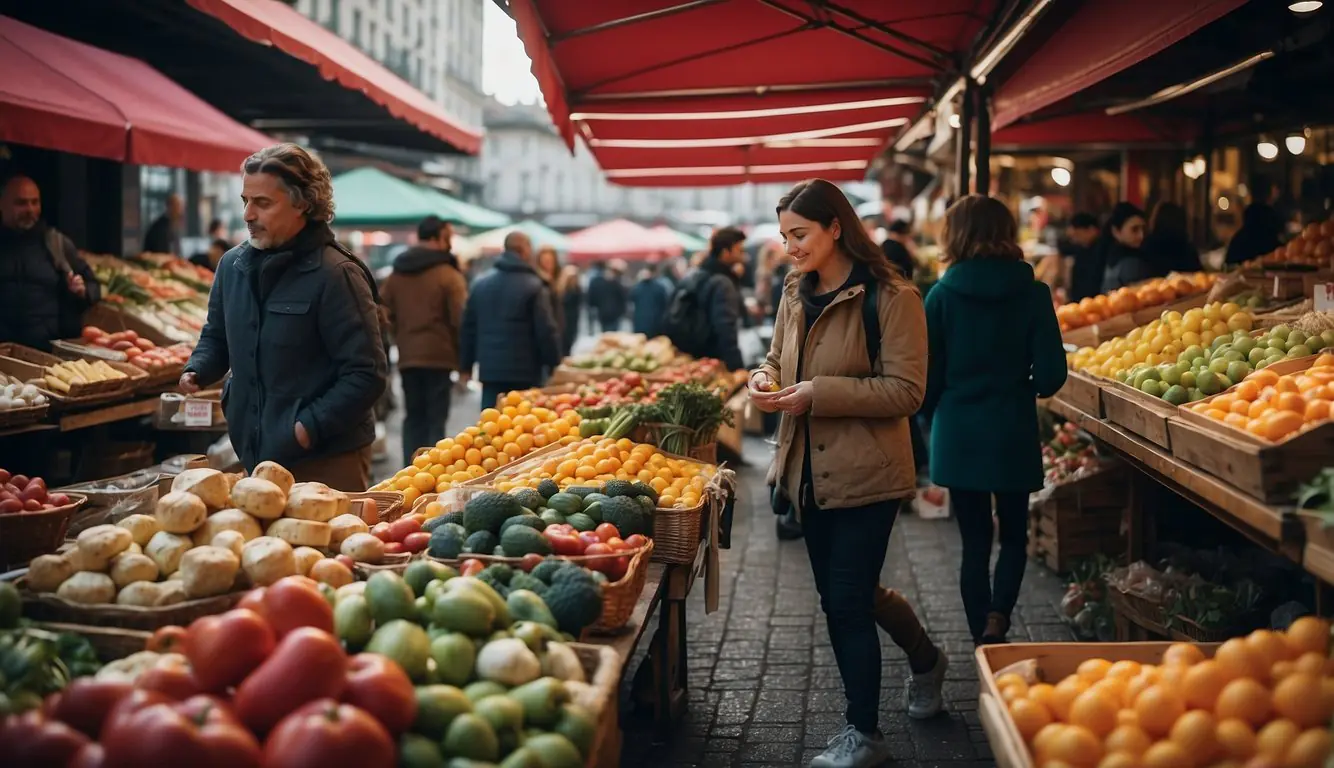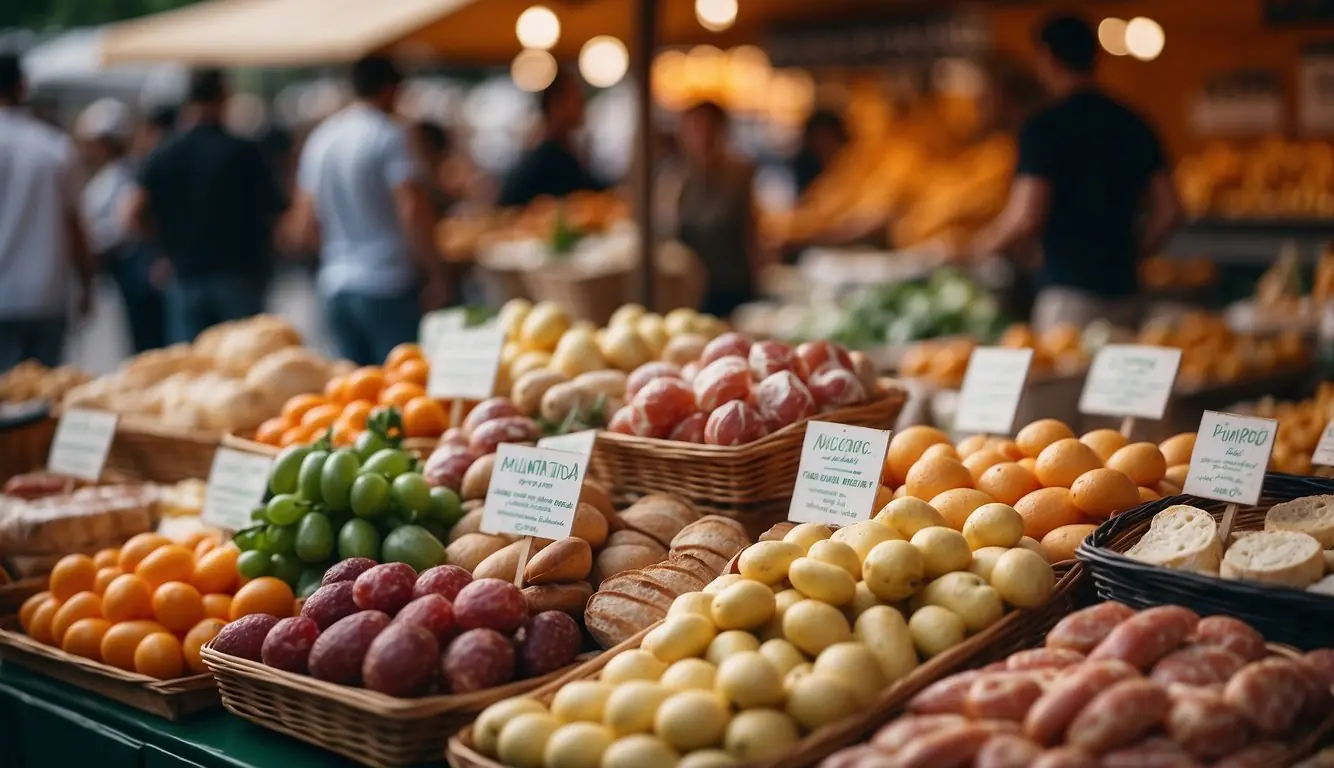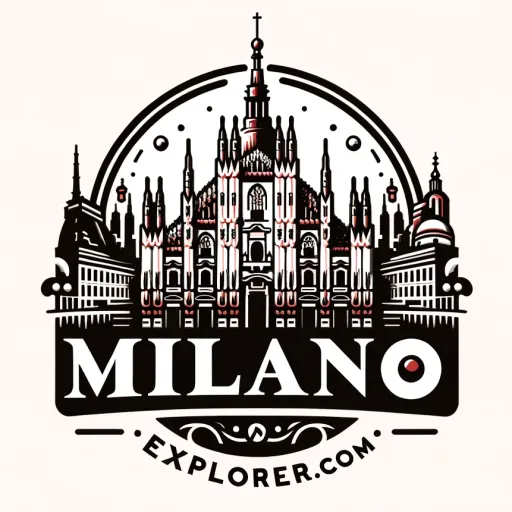Exploring Milanese food markets offers a unique way to experience the heart and soul of Milan. As we wander through these bustling markets, we find an array of vibrant stalls filled with fresh produce, traditional Italian delicacies, and local specialties. The best way to understand Milan’s rich culinary culture is through its diverse food markets.

One must-visit is the Mercato Papiniano, one of the largest in the city. This market operates on Tuesdays and Saturdays, attracting a mix of merchants, locals, and tourists. Another great spot is the Viale Papiniano Market, conveniently located near the Sant’Agostino metro station, where we can find everything from fresh vegetables to unique street food.
For those interested in a bit of everything, the Fiera di Sinigaglia is perfect. Held since the 19th century, it offers both food and antiques, making it an eclectic mix for shoppers and food enthusiasts alike.
Milanese Food Markets
Key Takeaways
- Milan’s food markets are central to experiencing its culinary culture.
- Viale Papiniano and Mercato Papiniano are top markets to visit.
- Fiera di Sinigaglia offers a mix of food and antiques.
History and Culture
Milan boasts a rich tapestry of history and culture, from its evolution as a city to its culinary traditions and prominence in fashion and art. Let’s explore how these aspects define Milan’s unique identity.
Milan’s Evolution
Milan has evolved significantly over the centuries. Originally a small Roman settlement, it grew into a major medieval city. The construction of the Navigli canals in the 12th century improved Milan’s trade and transport.
By the Renaissance, Milan became a center for art and learning, influenced greatly by Leonardo da Vinci who designed innovative canal locks. Today, the city continues to blend historical and modern elements, reflecting its dynamic evolution.
Culinary Traditions
Milan’s culinary traditions are deeply rooted in Italian cuisine. Dishes like Risotto alla Milanese, which is known for its saffron-infused flavor, reflect the city’s love for rich and aromatic food. Cotoletta alla Milanese, a breaded veal cutlet, and Ossobuco, braised veal shanks, are other staples.
Polenta also plays a significant role. These dishes tell a story of Milan’s history and its residents’ palates. Street markets such as the Valvassori Peroni Market and Viale Papiniano Market offer locals and tourists a taste of these traditional flavors.
Fashion and Design
Milan is synonymous with fashion and design. Home to luxury brands like Gucci, Prada, and Dolce and Gabbana, the city exudes elegance. Milan’s Brera District is renowned for its high-end clothing and accessories.
Each year, Milan Fashion Week draws fashion enthusiasts from all over the world. The stylish appeal of Milan extends beyond clothing to its architecture and interior design, making it a hub for creators and consumers of beauty and style.
Art and Sightseeing
Art and sightseeing are integral to Milan’s appeal. The Sforza Castle is a must-visit for those interested in Renaissance art and history. The streets of Brera are filled with galleries and exhibits that showcase Italian culture.
Landmarks like the Duomo di Milano and La Scala opera house attract countless visitors. Navigli Grande offers scenic views and a vibrant nightlife, making it a popular site for both locals and visitors.
Local Markets and Antiques
Milan’s local markets are treasure troves of antiques and unique finds. The Fiera di Sinigaglia is a historic flea market that features vintage clothing, furniture, and other antique items. The Mercatone dell’Antiquariato on the Navigli is another notable market, perfect for finding hidden gems.
During the holiday season, the Oh Bej! Oh Bej! Christmas Market in Porta Genova showcases a variety of niche items and traditional Italian delights. Markets like these highlight the rich and diverse marketplace culture that is quintessentially Milanese.
Milan’s Food Scene
Milan’s food scene is a blend of traditional Milanese cuisine and modern culinary innovation. Whether dining in elegant restaurants or savoring street fare, Milan offers a rich gastronomic experience.
Dining and Restaurants
Milan boasts a diverse array of dining options. From upscale restaurants in the Brera district to cozy cafes by the Duomo. We find that the city offers a mix of traditional and contemporary dining experiences. Italian cuisine is a staple here with many establishments serving pasta, risotto, and fresh seafood.
In particular, Milanese cuisine like Risotto alla Milanese reflects the city’s rich history and sophisticated gastronomy. Fine dining spots often pair these meals with local wines and cheeses, making for an exquisite culinary experience.
Typical Milanese Dishes
Tradition plays a big role in Milanese dishes. Risotto alla Milanese, with its distinctive saffron flavor, is a must-try. Another classic is Osso Buco, a tender veal shank braised with vegetables and broth. Cotoletta alla Milanese, similar to a breaded veal cutlet, is also a favorite.
We also love Risotto al salto, which makes use of leftover risotto that is fried until crispy. For appetizers, olives and cold meats like Bresaola are popular. Desserts often include delicious gelato or sweet pastries like panettone.
Street Food and Snacks
Milan’s street food scene is vibrant, with plenty of options for snacks on the go. You can find food trucks, kiosks, and small delis offering panzerotti—a fried turnover stuffed with cheese and tomatoes. Another favorite is arancini, rice balls filled with ragù or cheese and then deep-fried.
Focaccia and other freshly baked breads are commonly enjoyed as quick bites. For a sweet treat, locals often grab a cup of gelato from one of the many gelaterias scattered throughout the city. Pastries and small cakes are also readily available for an afternoon snack.
Markets and Groceries
Milan’s food markets are a cornerstone for fresh and local produce. The Viale Papiniano Market, one of the city’s largest, offers a wide variety of items from fresh fruits and vegetables to meats and fish. Many vendors specialize in cheeses, breads, and cold meats.
These markets provide everything needed for a home-cooked meal or a casual picnic. We often explore these markets to find the best local ingredients, contributing to the city’s reputation for high-quality groceries and a strong culinary culture.
Whether it’s high-end restaurants or bustling street food stalls, Milan’s food scene is both rich and diverse.
Shopping in Milan

When it comes to shopping in Milan, visitors can explore luxurious fashion districts, unique local boutiques, and bustling street markets. Each area offers distinct experiences, catering to various tastes and budgets.
High-End Fashion Districts
Milan is renowned for its high-end fashion districts, especially Quadrilatero d’Oro. This area is home to prestigious brands like Gucci, Prada, and Dolce and Gabbana. Here, we find flagship stores along Via Montenapoleone, Via della Spiga, and Via Sant’Andrea.
Walking through these streets feels like stepping into a world of elegance and refinement. We can admire the beautifully crafted accessories, jewellery, and the latest in high fashion. This district is not just about shopping; it’s also about experiencing the opulence and artistry of Italy’s top designers.
Local Shops and Boutiques
For a taste of Milan’s local charm, we head to areas like the Brera District. Known for its artistic vibe, this area boasts quaint local shops and boutiques. Here, we can find unique home decor, vintage clothes, and handmade jewellery that reflect Milan’s rich culture.
The Brera District is also home to charming cafes and galleries, making it a perfect spot to spend an afternoon wandering and exploring. We might stumble upon an antique market, where we can discover hidden treasures and unique fashion pieces that aren’t found in mainstream stores.
Street Markets and Vintage Finds
Milan’s street markets are vibrant hubs of activity. One of the largest is the Viale Papiniano Market, where we can find a mix of vintage clothes, fresh produce, and household appliances. It offers a wide variety of products at great prices.
For those interested in antiques and collectibles, the Naviglio Grande Flea Market is a must-visit. Held on the last Sunday of the month, this market features an array of vintage records, dolls, and other unique items. It’s a delightful place to find one-of-a-kind souvenirs.
In Milan, shopping is not just an activity; it’s an adventure through the city’s rich tapestry of fashion, culture, and tradition. Whether we’re hunting for high fashion, unique local items, or vintage treasures, Milan has something to offer everyone.
Conclusion

Exploring Milanese food markets offers a delightful journey through the city’s culinary diversity. Whether you’re searching for fresh produce or delicious street food, Milan has something to tempt every palate.
At the Viale Papiniano Market, we encounter a wide variety of products. It is one of the largest and most bustling markets in the city, conveniently located near the Sant’Agostino metro station. This market offers everything from clothing to fresh food.
For those interested in diving into local flavors, the Mercato di Porta Romana is a must-visit. It is one of Milan’s oldest markets, filled with vendors selling fresh fruits, vegetables, cheeses, and meats. The lively atmosphere makes it a perfect stop for food enthusiasts.
Another highlight is the Ravioleria Sarpi. Located on Via Paolo Sarpi, it is famous for its handmade dumplings. Watching the chefs prepare these delicious treats through the glass window is an experience in itself.
Milan’s street food also includes unique dishes like farinata. This chickpea flour pancake, typically baked with olive oil and sea salt, provides a savory snack that is different from traditional pancakes.
Each market and food stall we visit tells a story of Milan’s rich culinary heritage. From traditional recipes like Risotto alla Milanese to global influences found in Chinatown, the journey is both educational and delicious. Exploring these food markets not only satisfies our taste buds but also connects us to Milan’s vibrant culture.
Frequently Asked Questions
We’re here to help you navigate the exciting world of Milanese food markets. From iconic dishes to market schedules, we’ll answer common questions to enhance your food adventure in Milan.
What are the typical foods I should try at Milanese food markets?
Milan is famous for Risotto alla Milanese, with its rich saffron flavor. You should also try Cotoletta alla Milanese, a breaded veal cutlet, and Panettone, a sweet bread loaf. Additionally, look for fresh gelato and pasta made from local recipes.
Where can I find local food markets in Milan?
Mercato Papiniano is a bustling market on the main street, open on Tuesdays and Saturdays. Another popular spot is the historic Piazzale Lagosta market in the Isola district, which reopened with an innovative format. Both offer a variety of local produce and specialties.
Which Milanese food market is renowned for its authenticity and local cuisine?
For a genuinely local experience, head to Viale Papiniano Market. It’s the largest street market in Milan, with a broad selection of products and local foods. Conveniently located near the Sant’Agostino metro station, it is a favorite among locals and tourists alike.
What time do food markets typically open in Milan?
Most food markets in Milan start early. For instance, Mercato Papiniano operates from early morning until mid-afternoon. It’s best to visit between 8 AM and 2 PM to enjoy the full range of fresh produce and street food.
Can you recommend any budget-friendly food markets in Milan for tourists?
Mercato Papiniano is a great option for budget-conscious travelers. The Largo Alpini market, which operates on the same days as Mercato Papiniano, also offers good deals. These markets provide a wide array of affordable and high-quality local foods.
What are some indoor food markets in Milan for a rainy day?
The market at Piazzale Lagosta in the Isola district is a perfect indoor destination. Reopened in 2022, it features a covered area where you can shop for genuine products and enjoy quality food. It’s an excellent choice if you want to avoid the rain while exploring Milanese cuisine.
